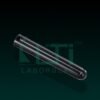- These Polypropylene / Polystyrene tubes are generally used in RIA, Coagulation & Bacteriology.
- The Polypropylene tubes are clear and can with stand 3000 RCF during centrifugation while the transparent Polystyrene tubes can with stand 1400 RCF.
- The PP tubes can accept common acids, alkalies & solvents at room temperature while the PS tubes can accept mild bases, weak acids but not organic solvents.
- Material : Polypropylene / Polystyrene
| PART NO. | PARTICULARS | PACK Qty. |
| 7890-12PS | RIA Vail 12 x 75 mm / PS | 500 |
| 7890-12PP | RIA Vail 12 x 75 mm / PP | 500 |
Here are the key uses of RIA vials:
- Sample Collection:
- RIA vials are used for collecting and storing biological samples, such as blood serum, plasma, urine, or other fluids, which contain the substance of interest (analyte).
- Sample Preparation:
- These vials are employed in the preparation of samples for RIA analysis. This may include steps such as extraction, purification, or dilution to ensure accurate and reliable results.
- Addition of Reagents:
- RIA involves the addition of specific reagents, including radiolabeled substances and antibodies, to the samples. RIA vials are designed to accommodate the addition of these reagents without compromising the integrity of the analysis.
- Incubation:
- After the addition of reagents, RIA vials are used during the incubation step, allowing the reaction between the analyte and the radiolabeled reagent to take place. This step is crucial for the formation of the immune complexes.
- Separation:
- Some RIA protocols involve a separation step to separate free and bound fractions of the radiolabeled substance. RIA vials may be used in centrifugation or filtration processes during this step.
- Radioactivity Measurements:
- RIA vials are designed to facilitate the measurement of radioactivity using a gamma counter or scintillation counter. The level of radioactivity is proportional to the concentration of the analyte in the sample.
- Calibration Standards and Controls:
- Calibration standards and quality control samples are often prepared in RIA vials to ensure the accuracy and precision of the assay. These samples help establish a standard curve for quantification.
- Storage:
- RIA vials may be used for the temporary or long-term storage of prepared samples before or after analysis. Proper storage conditions are crucial to maintaining sample stability.
- Automation:
- In automated RIA systems, specialized RIA vials compatible with automation platforms may be used for increased efficiency and throughput.
- Quality Assurance and Validation:
- RIA vials play a role in quality assurance by providing a controlled environment for the various steps involved in the RIA process. They are also used in the validation of RIA assays.







